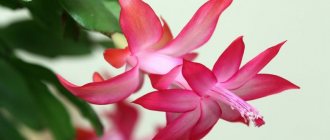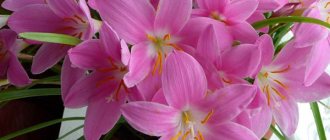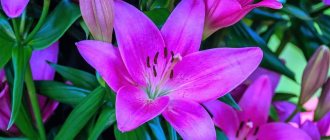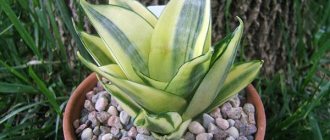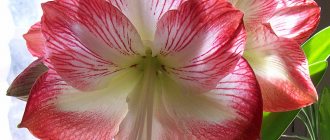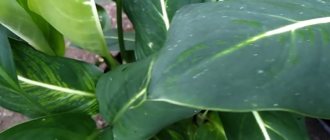Lantana is a relative of the well-known garden verbena and belongs to the same Verbenaceae family. The natural habitat of this shrub is the tropics; it is most widespread in the tropical regions of South America. Wild lantana can also be found in warm regions of Europe, where it came as a cultivated plant and acclimatized, turning into a weed. In Russia, lantana is grown as a houseplant and as a garden annual. It is valued primarily for its beautiful flowers, reminiscent of verbena flowers and capable of changing shade as they bloom.
Types of lantana
a hundred species in total, but the most cultivated plant is Lantana camara (1). This is an evergreen shrub with erect shoots up to 150 cm high (in indoor culture - 50 - 60 cm). The leaves are oval, green with a grayish tint, a sharp tip, a serrated edge and a specific odor. The flowers are small, tubular in shape, collected in a dense round inflorescence. As they bloom, their hue changes very noticeably, so lantana inflorescences can be two-colored, for example, yellow in the middle and red at the edges. Flowering is long, from early summer to mid-autumn. Some varieties are capable of setting seeds that look like dark berries. They are poisonous, so it is recommended to remove them.
There are hybrids and varieties of lantana vaulted on sale, but the range of them in stores is small. Mainly the following varieties are presented:
- Crocea – the flowers of this lantana variety are yellow at the beginning of bloom, gradually turning red;
- Mixta - flowers change shade from yellow to lilac;
- Nivea - the flowers are white, gradually acquiring a bluish tint, the inflorescences have an elegant “lace” appearance;
- Lyubava - buds and newly opened flowers are orange, turning red or pink when blooming; this variety of lantana flower is often offered in seed form.
Variety Crocea. Photo: pixabay.com
Mixta variety. Photo: pixabay.com
Variety Nivea. Photo: pixabay.com
Variety Lyubava. Photo: pixabay.com
There are other varieties of lantana, including those with monochromatic inflorescences, but it is difficult to find them on sale - for this you need to contact collectors.
Occasionally, in indoor culture you can find another type of lantana - Montevideo lantana (Lantana montevidensis) (2). It is more compact, has drooping shoots and pink-violet flowers that almost do not change shade.
Description of the plant
Lantana is a perennial plant belonging to the Verbena family. It grows naturally in Mexico, India, Central Asia and Colombia. Lantana has the appearance of a spreading shrub with branched shoots. Some of its varieties can grow up to 3 m in height.
What does lantana look like?
For your information! The root system is well developed, so to grow a lantana flower at home it needs space.
Mature shoots of the bush are covered with bark. Some varieties have thorns. The leaves are attached by petioles and can be arranged in a spiral or opposite each other. They grow ovoid in shape with slight pubescence and small teeth. Their average length is 5-7 cm. The leaf blade can be painted a rich green color, when some varieties are characterized by the presence of light green stripes.
Flowering usually begins in May and lasts until mid-September. The spherical inflorescences grow from the axils of the leaves, to which they are attached with a long peduncle. Despite the small size of the flowers, they have a pleasant, intense scent.
Lantana bloom
Note! During the entire flowering period, tubular flowers can change their color from white or yellow to pink and even red.
Caring for lantana at home
Caring for lantana is generally not difficult; the only difficulty in growing is maintaining the required temperature in winter, since the plant must be kept cool during the dormant period (3).
Priming
The soil for lantana requires light, air- and moisture-permeable soil, with moderate fertility, since in too nutritious substrates it actively forms green mass, but blooms worse. Indoor lantana can be planted in a ready-made soil mixture for flower crops, ficus or palm trees - the main thing is that it contains sand and raising agents (perlite or vermiculite).
To prepare your own soil mixture, you usually take leaf soil, humus and sand in equal parts.
Lighting
Like other beautiful flowering plants, lantana needs bright light. Direct sunlight usually does not harm it, with the exception of very young and newly transplanted plants; when grown in a south-facing window, they will require shading from the summer sun.
In winter, despite the dormant period, the plant should also be in a well-lit place.
Temperature
This is the only difficult moment in caring for a lantana flower. In the warm season, the optimal temperature for this plant is from 20 to 26 °C. In summer, it is very advisable to take it out into the fresh air - onto the veranda or balcony. The coolness of the night does not harm the plant unless the weather is extremely cold.
The wintering temperature of lantana is 10 - 16 °C or even slightly lower, and the plant should be in the light for at least 6 - 7 hours a day. Wintering in warmer conditions is acceptable, but has a bad effect on flowering, although lantana hybrids tolerate it better than species and varietal plants. During wintering, lantana may lose some leaves, but with the onset of spring its crown usually recovers.
When growing lantana in an apartment, you need to ensure that the plant is not in a draft, and that the leaves and pot do not come into contact with cold window glass or frame.
Watering
Watering lantana depends on the size of the plant and the phase of its life cycle: large-growing plants are watered more abundantly, and the watering regime differs in summer and autumn.
During the growing season, from spring to autumn, watering should be abundant and regular, 2 - 3 times a week, between waterings the top layer of soil should dry out. It is impossible to completely dry the substrate, as this leads to loss of foliage and buds.
In the cold season, when the plant is at rest, watering should be rare, once every 1.5 - 2 weeks, and moderate - so that the earthen ball becomes moist, but not wet. Overwatering is detrimental for this plant, as it leads to rotting of the roots.
Any water that gets into the tray must be drained immediately. Water for watering lantana should be soft, well-settled, and at room temperature. Periodic loosening of the soil after watering is very useful for lantana - this improves root aeration.
Humidity
The plant can easily tolerate low air humidity, but in such conditions it gets sick more often, grows slowly and blooms worse. It is advisable to spray lantana, especially in extreme heat and in the off-season, when the heating is still on. When spraying, water should not get on the flowers and buds, so it is best to place the blooming lantana in a tray with wet expanded clay, sphagnum or crushed stone.
Fertilizers
For feeding lantana, ready-made liquid mixtures intended for flowering indoor plants are suitable, in a concentration of 1/2 of that specified in the instructions.
Feeding
During the growing season, lantana is fed once every 2 weeks; during flowering and bud setting, the frequency of feeding can be increased to once a week. From mid-autumn until spring, when the plant is at rest, no fertilizing is applied.
Trimming
Pruning is very useful for lantana, as it stimulates tillering and the formation of young shoots on which flowers are formed. In early spring, before the growing season, the weak and oldest shoots of lantana are removed, and the remaining ones are shortened by about 1/3. Old shoots are considered to be those that have reached the age of 2 - 3 years. At the end of the season, you can shorten shoots that have grown too long. It is advisable to remove faded inflorescences before they form seeds.
Propagation of lantana at home
Lantana is not particularly durable: after 3 - 4 years the plant begins to age, produces fewer young shoots and, accordingly, blooms less often. There are 2 ways to propagate lantana.
By cuttings. A simple and convenient method, accessible even to an inexperienced gardener. To do this, cuttings up to 10 cm long with several pairs of leaves are cut from the tops of the shoots (you can use waste from spring pruning). It is best to root cuttings in the ground. Before this, the lower leaves are removed, the base of the cutting is dusted with Kornevin (4) and planted in a damp mixture of sand and peat. The container with cuttings is covered with transparent material and kept in a bright, moderately warm place (18 - 20 ° C). The substrate is periodically moistened with a spray bottle, the container is ventilated once a day.
After about 20 days, the cuttings take root, after which it is advisable to move them to a cooler place. When several leaves have formed on young plants, they can be planted in separate containers, pinching the tops to stimulate tillering.
Seeds. This method is more difficult. Seeds are sown in February (it can be earlier if it is possible to provide additional illumination with a phytolamp to the seedlings). The soil for sowing should be light and permeable - you can take a ready-made soil mixture for seedlings or for indoor plants and add vermiculite there. The seeds are lightly pressed into the moist soil, without sprinkling on top, the distance when sowing is 8 - 10 cm. The crops are covered with a transparent lid and kept in a bright place at a temperature of about 20 - 22 ° C. The substrate is periodically moistened, the container is ventilated daily.
After the seedlings emerge, the container with the seedlings is transferred to a cooler place, the lid is removed when two true leaves appear. When the young plants get stronger and reach a height of 10 - 12 cm, they can be planted in separate small containers. If lantana seedlings stretch out, this is a signal that the plants do not have enough light, so it is necessary to provide additional lighting or move the container to a brighter place.
Lantana transplant at home
The best time to transplant lantana is the end of winter - the beginning of spring; you can do this simultaneously with spring pruning. The new pot should be only slightly larger than the previous one (2 - 3 cm), since in a container that is too spacious, lantana grows the root system to the detriment of the growth of the above-ground part and flowering.
The plant is removed from the pot along with the earthen lump; the roots are not cleaned, but only slightly shaken off from excess soil. When backfilling, carefully press down the soil without compacting it. When replanting lantana, make sure that the root collar is at the same level as in the previous pot.
After transplantation, the plant is watered and placed in a shaded place for several days. There is no point in replanting lantana that is more than 3-4 years old - it is easier to cut it out.
Features of plant flowering
The lantana flowering period begins as early as May and can last until early autumn. The inflorescences are spherical in shape and can be colored yellow, white and other colors depending on the variety.
Lantana flowers are colored in different colors
Important! When the inflorescences fade, it is recommended to cut them off. If this is not done, the berries that appear will have a negative impact on future flowers. In addition, they are poisonous to animals and humans.
Lantana diseases
Root rot. A dangerous lantana disease that can very quickly destroy the plant. Appears due to improper watering or too dense a substrate - all this leads to stagnation of moisture in the soil. Signs of root disease are stunted growth, falling leaves, buds and flowers.
The diseased plant must be removed from the pot and the roots examined. If the root system is severely affected, it will no longer be possible to save the plant. In case of minor damage, the rotted roots are removed, the root system is cleared of soil and soaked for some time in a pink solution of potassium permanganate or a fungicidal preparation (Ordan, Alirin-B, Vitaros (4)). The plant is transplanted into fresh soil, which can be treated with a liquid fungicide according to the instructions for prevention.
Gray rot. It affects the above-ground part of the plant and appears mainly on weakened plants that are kept in unsuitable conditions (strong shading, insufficient or excessive fertilizing, drafts, improper watering). Signs of this disease are watery spots on the leaves and shoots, which increase in size over time and become covered with a characteristic grayish coating. The affected parts of the plant soften and die.
To combat gray rot, remove all affected parts of the plant and treat it with a fungicide (Hom, Bordeaux mixture 1%, Topaz, Skor (4)). It is also advisable to treat the surface of the soil in the pot. In case of severe damage, several treatments may be required at a certain time interval.
Recommendations
- Munir A. (1996). “Taxonomic review of Lantana camara L. and L. montevidensis (Spreng.) Briq. (Verbenaceae) in Australia." Journal of the Adelaide Botanic Gardens
.
17
: 1–27. - "Lantana aculeta L." US National Plant Germplasm System (NPGS). Retrieved January 6, 2022.
- ^ a b c d f f
“Global Invasive Species Database.” issg.org.uk. Archived from the original on 2014-04-07. Retrieved 2014-03-22. - ^ a b
Floridata LC (2007). "Lantana camara." Floridata LK. Retrieved March 24, 2014. - Moyhill Publishing (2007). "English and Latin names". Moyhill Publishing. Retrieved March 24, 2014.
- ^ a b c d e
Quentin K. B. Cronk, Janice L. Fuller (1995).
Plant Invaders: A Threat to Natural Ecosystems
. Royal Botanic Gardens, Kew: Springer. ISBN 978-0-412-48380-6. - "Lantana camara." Plant rescue. Retrieved July 20, 2018.
- "Lantana". BBC Plant Finder
. - ^ a b c
Day, M. D. (December 24, 2003).
Lantana: Current State of Management and Future Prospects
. Australian Center for International Agricultural Research. ISBN 978-1863203753. Retrieved March 24, 2014. - ^ a b c
Ghisalberti, E. (2000).
"Lantana camara L. (Verbenaceae)." Herbal medicine
.
71
(5):467–486. Doi:10.1016/S0367-326X(00)00202-1. PMID 11449493. - Sharma, O.M.P.; Harinder, Paul S (1988). "Review of the poisonous plant Lantana camara". Toxicon
.
26
(11):975–987. Doi:10.1016/0041-0101(88)90196-1. PMID 3072688. - Kohli, Ravinder. K. (2006). "Status, invasiveness and ecological threats of three tropical American invasive weeds (Parthenium hysterophorus L., Ageratum conyzoides L., Lantana camara L.) in India." Biological invasions
.
8
(7):1501–1510. Doi:10.1007/s10530-005-5842-1. S2CID 23302783. - Ensby, Rob. “Lantana is a national herb.”
- Sharma, O.P. (1981). "Review of the Toxicity of Lantana camara (Linn) to Animals." Clinical toxicology
.
18
(9):1077–1094. Doi:10.3109/15563658108990337. PMID 7032835. - MOHAN RAM, H.Y. (1984). "The color of the flower changes in Lantana Camara
."
Journal of Experimental Botany
.
35
(11):1656–1662. doi:10.1093/jxb/35.11.1656. - Weiss, Martha. R. (1990). "COLOR CHANGES AS A MOMENT FOR POLLINators." Magazine citation required | log = (help)
- Rosacia, W. Z.; and others. (2004). "Lantana and Hagonoy: Noxious Weeds Common in Grasslands and Grasslands" (PDF). Ecosystem Research Information Series
.
16
(2). Retrieved July 27, 2011. - "Lantana camara." 2008.
- Florida Council on Exotic Plant Pests (2005). "Florida Council on Exotic Plant Pests: Lantana camanara
" (PDF). Florida Council on Exotic Plant Pests. - Sanders, R.W. (2012). "Taxonomy of lantana sect Lantana (Verbenaceae)". Journal of the Texas Botanical Research Institute
.
6
(2): 403–442. - ^ a b
Gentle, K. B. (1974).
" Lantana camara
L. invasions in tropical dry forests—open forest ecotones: the role of disturbances from fire and grazing."
Australian Journal of Ecology
.
22
(3):298–306. Doi:10.1111/j.1442-9993.1997.tb00675.x. - "Lantana camara." October 2006
- ^ a b
Thaman, R. R. (2006).
"Lantana camara: introduction, distribution, and impacts on tropical Pacific islands." University of Guam Journal of Micronesia
.
10
: 17–39. - "Forest Invasive Species: Country Report" (PDF). Food and Agriculture Organization of the United Nations. Magazine citation required | log = (help)
- S. Ranwala, B. Marambe, S. Wijesundara, P. Silva, D. Weerakoon, N. Atapattu, J. Gunawardena, L. Manawadu, G. Gamage, Assessing the current risk of invasive alien flora in Sri Lanka, GAP analysis and the most dangerous alien invaders, Pakistan Journal of Weed Research
, Special Issue, October 2012: 863-871. - "Forest Invasive Species: Country Report" (PDF). Food and Agriculture Organization of the United Nations. Retrieved March 23, 2014. Journal Citation Requires | log = (help)
- Duggin, J. A.; Gentle, C. B. (1998). "Experimental evidence for the importance of disturbance intensity for the invasion of Lantana camara L. in tropical dry forest and open woodland ecotones in north-eastern New South Wales, Australia." Ecology and forest management
.
109
(1–3):279–292. Doi:10.1016/S0378-1127 (98) 00252-7. - Fensham, R. J.; Fairfax, RJ; Cannell, R. J. (1994). "Invasion of Lantana camara L. in Forty Mile Scrub National Park, north Queensland." Australia Ecology
.
19
(3):297–305. Doi:10.1111/j.1442-9993.1994.tb00493.x. - Berry, Z. C.; Wevill, K; Curran, T. J. (2011). “The invasive weed Lantana camara increases fire risk in tropical dry forests due to changes in fuel loading.” Weed Research
.
51
(5):525–533. doi:10.1111/j.1365-3180.2011.00869.x. - Okoth J. O. (1987). "Study of Glossina fuscipes fuscipes (Newstead) resting sites in relation to Lantana camara thickets, coffee and banana plantations in a sleeping sickness hotspot, Busoga, Uganda." Uganda Trypanosomiasis Research Organisation
.
8
: 57–60. Doi:10.1017/S1742758400006962. S2CID 87065966. - “The influence of the growth of weeds Lantana camara and Chromelina odorata on species diversity, regeneration and stem density of the tree-shrub layer in the BRT reserve” (PDF).
- "Weed Control Guide - Lantana
" (PDF). Retrieved March 24, 2014. - Ross, Ivan. A. (1999). Medicinal Plants of the World
(PDF). Humana Press. paragraph 187. - Burns, D. (2001). Story's Encyclopedia of Horse Lovers: An A to Z Guide in English and Western Languages
. Storey Publishing. p. 302. ISBN 978-1-58017-317-9. - Barcellu, D. G. (2008). Medical toxicology of natural substances: food, mushrooms, medicinal herbs, plants and poisonous animals
. Wiley. pp. 867–8. ISBN 978-0-471-72761-3. - Ahmed. R (2007). "Allelopathic effects of Lantana camara on germination and growth of selected crops in Bangladesh." Journal of Forestry Research
.
18
(4): 201–304. doi:10.1007/s11676-007-0060-6. S2CID 61760. - Sharma O. P. (2007). "Review of the hepatotoxic plant Lantana camara". Critical Reviews in Toxicology
.
37
(4): 313–352. Doi:10.1080/10408440601177863. PMID 17453937. S2CID 23993698. - Duke and others.
(1996), Coppens d'Eeckenbrugge & Libreros Ferla (2000), TAMREC (2000) - Carstairs, S. D. et al. (December 2010). "Ingestion of Lantana Camara
does not cause significant effects in children."
Pediatrics
.
126
(6):e1585–8. Doi:10.1542/pedy.2010-1669. PMID 21041281. S2CID 36904122.CS1 maint: uses the authors parameter (communication) - "Management information". Global Invasive Species Database. Retrieved March 24, 2014.
- “Karnataka gets nature's gift to fight deadly weed - Times of India.” Times of India
. Retrieved 2017-08-21. - Khanna, L. S.; Prakash, R. (1983). Theory and practice of forestry systems
. International book distribution. - Chavan and Nikam (1982). "Study of leaves of Lantana camara Linn (Verbenaceae) for larvicidal activity." Magazine citation required | log = (help)
- Sathish, R.; and others. (March 2011). "Antiulcerogenic activity of Lantana camara
leaves on gastric and duodenal ulcers in experimental rats."
J Ethnopharmacol
.
134
(1):195–7. Doi:10.1016/j.jep.2010.11.049. PMID 21129476. - Barreto, F.; and others. (January 2010). "Antibacterial activity of Lantana Camara
Lynn and
Lantana montevidensis
Briga extract from Cariri Ceara, Brazil."
J Young Pharm
.
2
(1): 42–4. Doi:10.4103/0975-1483.62211. PMC 3035883. PMID 21331189. - Lehnert, Matthew S.; Kramer, Valerie R.; Rawlins, John E.; Verdecia, Vanessa; Daniels, Jaret K. (2017-07-10). "The Critically Endangered Butterfly of Jamaica: A Review of the Biology and Conservation Status of the Homerus Swallowtail (Papilio (Pterourus) homerus Fabricius)." Insects
.
8
(3): 68. doi:10.3390/insects8030068. PMC 5620688. PMID 28698508. - ^ a b
Gledhill, David (2008). "Names of plants." Cambridge University Press. ISBN 9780521866453 (hardback), ISBN 9780521685535 (paperback). 87,230 pp.
Lantana pests
Lantana can suffer from typical houseplant pests - aphids, spider mites, mealybugs, scale insects and whiteflies.
Aphid. A small insect without wings, most often greenish, which can be seen with the naked eye or with a magnifying glass with a slight magnification. Aphids usually cluster on the undersides of leaves.
Whitefly. A winged insect that can be seen not only on the plant itself: frightened whiteflies easily rise into the air and fly around. Some gardeners notice that the whitefly is the most common pest of lantana flowers.
Spider mites and mealybugs. They manifest themselves primarily as traces of vital activity: this is a cobweb coating on leaves and shoots or characteristic “cotton lumps” and sticky secretions on the leaves. If you carefully examine the plant, you can see small crawling pests on the back of the leaves and in the axils.
Scale insect (or false scale insect). This lantana flower pest is easily identified by specific oval brownish “growths” on parts of the plant. With severe damage, they can merge into a continuous crust.
To control pests in the initial stages, you can use green soap - the plant is washed with it several times at intervals of a week and a half. The scale insects are removed mechanically, carefully scraping off the stems and leaves.
If there are a lot of pests and they have thoroughly colonized the plant, you will have to resort to agrochemicals. For aphids, whiteflies, and mealybugs, you can use Fitoverm or Actellik; for spider mites and scale insects, it is better to use Aktara (4).
Popular questions and answers
Agronomist-breeder Svetlana Mikhailova answered typical questions from amateur flower growers
How to choose lantana?
Lantanas are very rarely sold in retail stores, so you will have to look for the plant in online stores or from collectors. This is the case when the plant cannot be inspected before purchasing, so look online for reviews about the store or private seller from whom you intend to buy the plant and the quality of its product.
What kind of pot do you need for lantana?
The pot for lantana should be about 3 cm wider than the root system. The depth of the pot must be chosen so that a layer of drainage 3-4 cm thick fits on the bottom. A clay pot is preferable: firstly, it heats up and cools more evenly, and, secondly, it is weighty and will become an additional “counterweight” for stability plants, because the crown of lantana is quite large and heavy.
Is it possible to root lantana cuttings brought from the south?
Of course, you can take a risk, although long transportation of the cutting reduces its chances of rooting. The cuttings may take root, but the likelihood of good growth and flowering of such lantana is not very high. Varieties and hybrids that are grown indoors are adapted to conditions that are very different from natural ones. An “outdoor” plant is unlikely to feel good in them.
Is it possible to grow lantana in open ground?
It is possible, in the Moscow region it is sometimes planted in flower beds as an annual, and in the southern regions - as a perennial. Sometimes lantana is used as a garden container crop: this is convenient, since the pots can be brought to a cool terrace for the winter, where the plant can safely overwinter.
A little about the history of the name of the flower
Latin America is considered the homeland of the evergreen shrub plant Lantana. Now it is widespread in the tropical and subtropical zones of America, Asia and Africa. This plant creates impenetrable thickets in places where it grows, displacing all other vegetation in its path. In India, locals jokingly call Lantana the “curse of the planters.” But in private lands, it pleases flower growers with its unpretentiousness, lush growth and beauty and abundance of inflorescences of different shades, which, moreover, exude a magnificent spicy aroma.
Mention of this plant first appeared in 1737 in the scientific work “Genera Plantarum” by the Swedish botanist and flora taxonomist Carl Linnaeus. The outline of the inflorescences in the form of corymbs reminded him of the inflorescences of the viburnum variety Gordovina, especially since the ancient Romans called viburnum Lantana. The name of the flower resurfaced again in 1753 in the scientific work "Species Plantarum", where the word Lantana, in Latin "Lantana", was mentioned as the name of a genus of plants from the Verbenaceae family. In total, about 150 species of Lantana are known, of which only Lantana Camara and its hybrids are cultivated.
Sources
- A working list of all plant species. Lantana camara // The Plant List https://www.theplantlist.org/tpl1.1/record/kew-107934
- A working list of all plant species. Lantana montevidensis // The Plant List https://theplantlist.org/tpl1.1/record/kew-1081813
- Hessayon D.G. All about indoor plants // M.: Kladez-Buks, 20054
- State catalog of pesticides and agrochemicals approved for use on the territory of the Russian Federation as of July 6, 2022 // Ministry of Agriculture of the Russian Federation https://mcx.gov.ru/ministry/departments/departament-rastenievodstva-mekhanizatsii-khimizatsii- i-zashchity-rasteniy/industry-information/info-gosudarstvennaya-usluga-po-gosudarstvennoy-registratsii-pestitsidov-i-agrokhimikatov/Cover photo: pixabay.com


